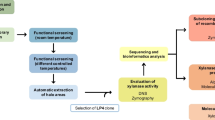Abstract
Zymography is a widely used technique for the study of proteolytic activities on the basis of protein substrate degradation. In this study, substrate immersing zymography was used in analyzing proteolysis of extracellular proteases. Instead of being added directly into a sodium dodecyl sulfate–polyacrylamide gel electrophoresis (SDS–PAGE) gel, the substrates were added into the immersing solution after electrophoresis. Substrate immersing zymography could accurately determine the molecular weight of trypsin, and band intensities were linearly related to the amount of protease. The diversity of extracellular proteases produced by different marine bacteria was analyzed by substrate immersing zymography, and large variations of proteolysis were evidenced. The proteolytic activity of Pseudoalteromonas strains was more complicated than that of other strains. Five Pseudoalteromonas strains and five Vibrio strains were further analyzed by substrate immersing zymography with different substrates (casein and gelatin), and multiple caseinolytic and gelatinolytic profiles were detected. The extracellular proteolytic profiles of Pseudoalteromonas strains exhibited a large intraspecific variation. Molecular weight (Mw) of the main protease secreted by Vibrio was 35 kDa. Additionally, the time-related change trends of the activities of extracellular proteases produced by Pseudoalteromonas sp. SJN2 were analyzed by substrate immersing zymography. These results implied the potential application of substrate immersing zymography for the analysis of the diversity of bacterial extracellular proteases.







Similar content being viewed by others
References
Barrett, A. J., Rawlings, N. D., & Woessner, J. F. (2003). The Handbook of proteolytic enzymes 2nd ed[M]. Academic.
Neurath, H. (1989). Proteolytic enzymes: a practical approach. 1–13.
Hunter, E. M., Mills, H. J., & Kostka, J. E. (2006). Applied and Environmental Microbiology, 72, 5689–5701.
van Dijl, J. M., & Hecker, M. (2013). Microbial Cell Factories, 12, 3.
Zacaria, J., Delamare, A. P. L., Costa, S. O. P., & Echeverrigaray, S. (2010). Journal of Applied Microbiology, 109, 212–219.
Gross, J., & Lapiere, C. M. (1962). Proceedings of the National Academy of Sciences of the United States of America, 48, 1014
Heussen, C., & Dowdle, E. B. (1980). Analytical Biochemistry, 102, 196–202.
Rossano, R., Larocca, M., & Riccio, P. (2011). Journal of Plant Physiology, 168, 1517–1525.
Hattori, S., Fujisaki, H., Kiriyama, T., Yokoyama, T., & Irie, S. (2002). Analytical Biochemistry, 301, 27–34.
Choi, N. S., Kim, B. H., Park, C. S., Han, Y. J., Lee, H. W., Choi, J. H., Lee, S. G., & Song, J. J. (2009). Analytical Biochemistry, 386, 121–122.
Kaberdin, V. R., & McDowall, K. J. (2003). Genome Research, 13, 1961–1965.
Vandooren, J., Geurts, N., Martens, E., den Steen, P. E. V., & Opdenakker, G. (2013). Nature Methods, 10, 211–220.
Dodia, M. S., Rawal, C. M., Bhimani, H. G., Joshi, R. H., Khare, S. K., & Singh, S. P. (2008). Journal of Industrial Microbiology and Biotechnology, 35, 121–131.
Wilder, C. L., Park, K. Y., Keegan, P. M., & Platt, M. O. (2011). Archives of Biochemistry and Biophysics, 516, 52–57.
Hummel, K. M., Penheiter, A. R., Gathman, A. C., & Lilly, W. W. (1996). Analytical Biochemistry, 233, 140–142.
Pan, D., Hill, A. P., Kashou, A., Wilson, K. A., & Tan-Wilson, A. (2011). Analytical Biochemistry, 411, 277–283.
He, H. L., Chen, X. L., Li, J. W., & Zhang, Y. Z. (2004). Food Chemistry, 84, 307–311.
Bradford, M. M. (1976). Analytical Biochemistry, 72, 248–254.
Laemmli, U. K. (1970). Nature, 227, 680–685.
Massaoud, M. K., Marokházi, J., & Fodor, A. (2010). Applied and Environmental Microbiology, 76, 6901–6909.
Lantz, M. S., & Ciborowski, P. (1994). Methods in Enzymology, 235, 563–594.
He, H. L., Guo, J., Chen, X. L., Xie, B. B., Zhang, X. Y., Yu, Y., Chen, B., Zhou, B. C., & Zhang, Y. Z. (2012). PLoS ONE, 7, e35442.
Zhang, X. M., Liu, N., Yang, F., Li, J. H., Wang, L. S., Chen, G. J., & Gao, P. J. (2012). Electrophoresis, 33, 280–287.
Duchesne, L. G. M., Lam, J. S., MacDonald, L. A., Whitfield, C., & Kropinski, A. M. (1988). Current Microbiology, 16, 191–194.
Schwarz, W. H., Bronnenmeier, K., Gräbnitz, F., & Staudenbauer, W. L. (1987). Analytical Biochemistry, 164, 72–77.
Zhou, M. Y., Chen, X. L., Zhao, H. L., Dang, H. Y., Luan, X. W., Zhang, X. Y., He, H. L., Zhou, B. C., & Zhang, Y. Z. (2009). Microbial Ecology, 58, 582–590.
Wang, Y., Nakajima, A., Hosokawa, K., Soliev, A. B., Osaka, I., Arakawa, R., & Enomoto, K. (2012). Bioscience Biotechnology and Biochemistry, 76, 1229–1232.
Kupai, K., Szucs, G., Cseh, S., Hajdu, I., Csonka, C., Csont, T., & Ferdinandy, P. (2010). Pharmacol Toxicol Methods, 61, 205–209.
Thuy, D. T. B., & Bose, S. K. (2011). International Journal of Biology, 3, 101–110.
Sakai, D. K. (1985). Applied and Environmental Microbiology, 50, 1031–1037.
Papa, R., Parrilli, E., Sannino, F., Barbato, G., Tutino, M. L., Artini, M., & Selan, L. (2013). Research in Microbiology, 164, 450–456.
Shinoda, S., & Miyoshi, S. (2011). Biocontrol Science, 16, 1–11.
Kim, C. M., Kang, S. M., Jeon, H. J., & Shin, S. H. (2007). Journal of Microbiological Methods, 70, 96–102.
Cera, E. D. (2009). IUBMB Life, 61, 510–515.
Acknowledgments
The work was supported by the National Natural Science Foundation of China (31070061, 31370104), Hunan Provincial Natural Science Foundation of China (13JJ9001), and National Sparking Plan Project (2013GA770009).
Author information
Authors and Affiliations
Corresponding authors
Rights and permissions
About this article
Cite this article
Liu, D., Yang, X., Huang, J. et al. In situ Demonstration and Characteristic Analysis of the Protease Components from Marine Bacteria Using Substrate Immersing Zymography. Appl Biochem Biotechnol 175, 489–501 (2015). https://doi.org/10.1007/s12010-014-1287-2
Received:
Accepted:
Published:
Issue Date:
DOI: https://doi.org/10.1007/s12010-014-1287-2




